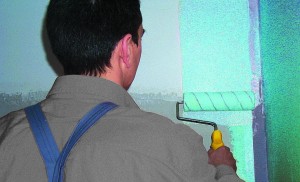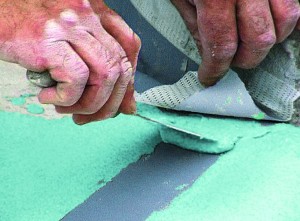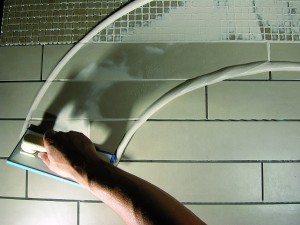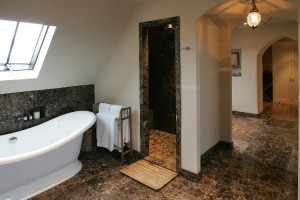This week I have invited Rob Sheppard, Managing Director of Kerakoll UK to talk about wet room systems.
The increase in popularity of showers and the exposure to continental design has led to wet rooms becoming increasingly popular. House owners see them as a good way of adding value to their home as well as a stylish alternative to a traditional shower tray, so it would pay any flooring and tiling professional to be able to offer them as part of his repertory.
There are many different systems on offer to aid installation of a wet room, but the main method is to raise the floor by installing a concrete screed and then to either install a form which is inset into the floor and creates the fall necessary to channel the water into the drain, or to create the slope manually, although it is more difficult to get the desired gradient this way. The whole room is then waterproofed before being tiled and a glass screen installed if desired.
The main concern for anybody installing a wet room is to ensure complete water tightness, the tiled surface should not be considered as water tight especially when the room is on an upper floor. The ideal way to do this is to use a waterproofing product on the floor before tiling. Kerakoll’s Idrobuild Eco creates a water resistant layer and can be used in showers and wet rooms. It has a high degree of adhesion even on non absorbent substrates and is compatible with cement based tile adhesives. A very environmentally friendly alternative in the same family of products is the FX version for walls which can be used on any absorbent substrate and is coloured so that you can see where it has been applied. It has very low VOC emissions, is solvent free and develops total water resistance so that it guarantees water tightness even in a wet room environment.
It is also possible to use a waterproofing membrane to achieve the same effect. This involves putting down an adhesive and then laying the membrane in panels on top ensuring that the sides of the panels meet exactly, not overlapping and leaving no gaps before taping over them with a waterproof tape. However the use of a waterproofing chemical rather than a membrane gives a one step process and removes concerns about water leakage through the membrane joins.
Once the waterproofing layer has been applied, all joints need to be sealed and this can be done with a flexible membrane such as Idrobuild Giuntoflex. This should be applied to all joints including perimeter and fracture joints. Giuntoflex seals even expansion joints. It bonds directly on application and is available in various sizes for different types of joints, such as a tape for wall and floor joins, internal and external corners and flanges for larger areas. It is designed for use under ceramic and porcelain tiles and natural stone.
After the room has been waterproofed the desired aesthetic look can be achieved with the choice of tiles. Any floor tiles are suitable for a wet room floor whether ceramic, porcelain or natural stone, but larger tiles have to be cut to fit the gradient of the floor leading to the drain. Mosaics are a popular choice as they mould themselves to the shape of the floor more easily and provide a degree of slip resistance due to the grout joints.
Kerakoll provides a range of highly effective and eco friendly adhesives which are specially formulated for use in different situations or with different types of tile. However in most wet room situations H40 Tenaflex which is a flexible adhesive will work well in case there is any movement in the floor. It can be used for all types of tiles including most natural stones but for delicate natural stone tiles and terrazzo H40 Marmorex is ideal as it helps to stop staining and curling; both phenomena that can occur with these sorts of tiles.
The final stages of the process are the application of grout and then sealing with an appropriate silicone sealant. A fungicidal grout is the best choice and Kerakoll’s Fugabella Eco range is an eco friendly alternative that uses natural hydraulic lime to give it its antibacterial and fungicidal properties rather than relying on the biocides such as pesticides which are a more normal ingredient of this sort of product.
Finally seal the joins between the wall and floor with a suitable silicone sealant such as Fugabella Eco Silicone and you will have a wet room that should delight your customers and provide safe leak free use for as long as it is in service.
Kerakoll UK Ltd contact details:
Tel: 01527 578000
Email: info@kerakoll.co.uk
Copyright Ian Taylor and The Tile and Stone Blog.co.uk, 2013. See copyright notice above.







Been reading your blog a lot over the past few weeks, some really great stuff. Please have a look and see if there is anything on my website that may interest you for a guest post.